At the beginning of the 21st century, a Ukrainian scientist, Dr. Sergei Gorbenko, claimed to have discovered the remains of the Virgin Mary in the Basilica of Cléry-Saint-André, near Orléans. One more fake news?
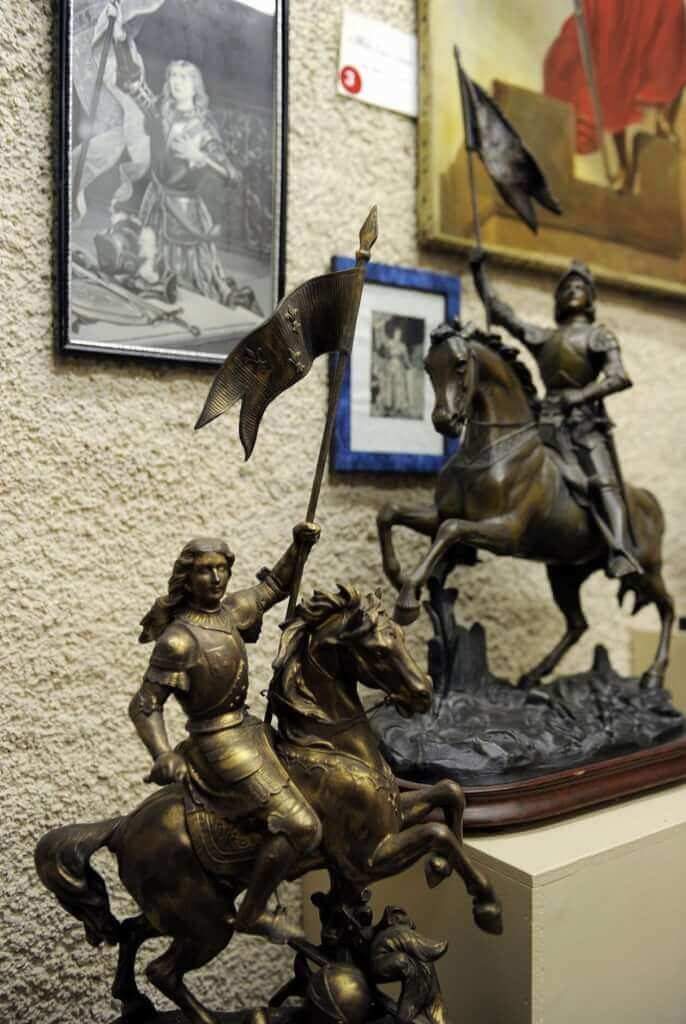
With the exception of Voltaire, who published in Geneva in 1752 a heroic-comic poem entitled La Pucelle d’Orléans, Jeanne was forgotten for several centuries. Until 1870.
The defeat at Sedan was a trauma for all French people. France lost the war against Prussia. Paris is occupied. Alsace and Moselle are annexed. The Republic is in the grip of a devastating civil war between clerics and anticlerics. The country must be reunited around a founding myth. We need to find a hero that no one will be able to challenge.
To respond to these demands, Church and State will join forces to make Jeanne, both saint and warrior, the symbol of national reconciliation.
Already, Bishop Félix Dupanloup of Orleans has asked the Pope to open a canonization trial. Jeanne was beatified in 1909 and canonized in 1920 for five small miracles accomplished through her intercession.
Raised to the rank of national cult, Jeanne would arouse irrational fervour. Thousands of streets, squares, colleges and high schools, secular and religious institutions are named after her. Jeanne inspired several tens of thousands of books (22,000 of which are listed at the Joan of Arc Centre in Orléans), as many articles in specialized magazines, six operas and some fifty films, the first of which, silent, was made in 1898 and lasts about 30 seconds.
Joan is everywhere. In the streets and in churches. More than 40,000 statues present the shepherdess or the warrior according to the more or less fanciful inspiration of the artists. For we do not know the features of Jeanne’s face. Advertising takes over. The name Joan of Arc is given to tins of sardines or camembert.
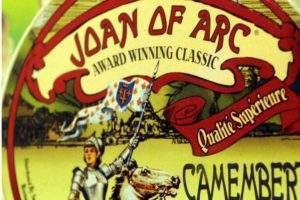
The history textbooks take up the marvellous epic of the Pucelle, a little shepherdess from Domrémy, guided by heavenly voices who saved France. The secular school takes up the implausibilities of 15th century stories. No question of questioning a founding myth of the Republic!
But if the legend is beautiful, the story is false.
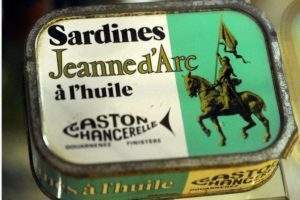
Excavations at Cléry-Saint-André
Although the church has always hidden the truth about Jane, historians and researchers have long been trying to unravel the mystery surrounding the Virgin Mary. Many books have questioned the official version. But they have not been widely disseminated.
In the second half of 2001 a Ukrainian scientist will make an extraordinary discovery, he says, in the tombs of the royal basilica of Cléry-Saint-André in the Loiret.
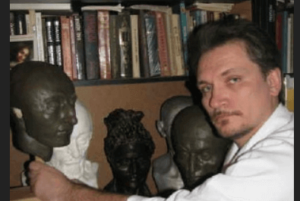
Dr. Sergei Gorbenko is a maxillofacial surgeon and historian. This double training leads him to work at the Institute and Museum of Anthropology and Facial Reconstruction in Lviv (Ukraine). The Institute has developed an ambitious programme to create a gallery of portraits of historical persons from the Middle Ages.
Sergueï Gorbenko came to work in France. This world-renowned scientist has reconstructed the face of Saint Bernard de Clervaux, who died in 1153 and whose skull was placed in a reliquary and hidden by a priest to preserve it from the destruction of the Revolution.
Dr. Gorbenko also wishes to find the true face of the kings of France. In August 2001, he obtained permission to work on the skulls of Louis XI and his wife Charlotte of Savoy, which are kept in the Basilica of Notre-Dame de Cléry-Saint-André, near Orléans.
However, his initial investigations were rather disappointing. The bones preserved in the crypt actually belong to four different individuals.
Sergei Gorbenko does not stop there. He sets out in search of King Louis’ nose bone. He requests and obtains permission to carry out further excavations. First in the tomb of Tanneguy du Chastel, to the right of the staircase of the royal vault. Because of his great stature he had saved the king who, in gratitude, had him buried on his right.
In the interest of history
Dr. Gorbenko soon discovered that there were mixed bones of several skeletons. But above all, his own findings contradicted the excavations carried out at Cléry-Saint-André in the 19th century, in 1818, 1854, 1887 and 1889 to be exact.
The Ukrainian scientist therefore continues his research in the basement of the basilica. This time, he had the Saint-Jean Chapel, also known as the Longueville Chapel, opened, which houses the graves of Dunois, Jeanne’s companion in arms, his wife Marie d’Harcourt and some of their descendants. Open on the fifth and sixth bays of the south side of the basilica, this chapel is an architectural jewel. Built between 1464 and 1468 by Simon du Val, it was partially destroyed by the Huguenots. The three-quarter warhead vaults were rebuilt identically in 1655. At the keystones of the vaults are five badges with the arms of France and Longueville.
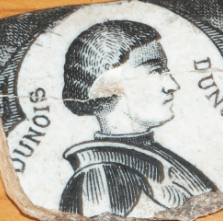
The Bastard of Orleans died on 24 November 1468 in L’Haÿ, near Bourg-la-Reine. The tomb of Dunois was visited several times. On 18 December 1854, by a commission of the Archaeological Society of Orléans, who had a stone sealed in the name of Dunois, and on 7 and 8 June 1887, on the occasion of authorised excavations in the chapel in the interest of the history of Cléry (sic).
Canon Lucien Millet, Dean-Priest of Notre-Dame de Cléry, recalls that the 1887 excavations were carried out under the direction of M. Dusserre, architect and Inspector of Historic Monuments, by M. Louis Jarry, Father Saget, parish priest and M. the Marquis de Tristan, mayor. The canon states that the place of all the tombs has been definitively fixed!
Louis Jarry who attended these excavations specifies (page 130): We contemplated with respectful emotion the remains of Joan of Arc’s companion in arms and admired the harmonious proportions of her skull with its wide and developed forehead.
The historian accurately describes the location of the bodies. We found in this vault, which had not been violated like several others, a large lead beer in the shape of a double sloping roof, bent under the weight of another beer made of the same smaller metal, probably the body of a child on top of that of his mother….
Dr. Gorbenko was surprised by these repeated excavations at such short intervals whose scientific data did not match his own discoveries. More curiously, new and more complete excavations, Canon Lucien Millet tells us, were carried out by Father Louis Saget in 1889.
It should be noted that 1887 and 1889 correspond to the beginnings of the canonization of Jeanne, which Bishop Dupanloup, Bishop of Orleans, so ardently demanded.
Photos and videos
Sergueï Gorbenko, after having explored the cellars of Louis XI and Tanneguy du Chastel, had the Dunois cellar opened on 27 November 2001 by a marble mason. He discovered several tombs and several coffins but their descriptions did not correspond to those of Louis Jarry or the priest Louis Saget. Instead of the remains of Marie d’Harcourt and her son there are male bones.
Dr. Gorbenko enters another tomb, to the left of the Dunois tomb, having some stones removed. There is a lead coffin there and inside the bones of a woman, apparently a large one. Then he discovers other bones and archaeological objects.
The scientist takes photos and shoots videos. On one of them he clearly sees the date June 7, 1887 written on a wall of this tomb. Obviously, the upheavals are numerous. Dr. Gorbenko deduced that the contents of the tombs were deliberately altered. In his opinion, the commission of 1887 did not reveal the real reasons for the opening of the tomb of Dunois. He also believes that the parish priest Louis Saget moved the bones.
To cover his tracks? Perhaps he did.
A secret convention…
Finally, after his long study, Dr. Gorbenko was able to identify most of the bones. He claims to be able to reconstruct the true face of Louis XI, the face of Tanneguy du Chastel, and he certifies that a skull of a woman who is not Charlotte of Savoy but an even more interesting character can be reconstructed! Without saying who it is.
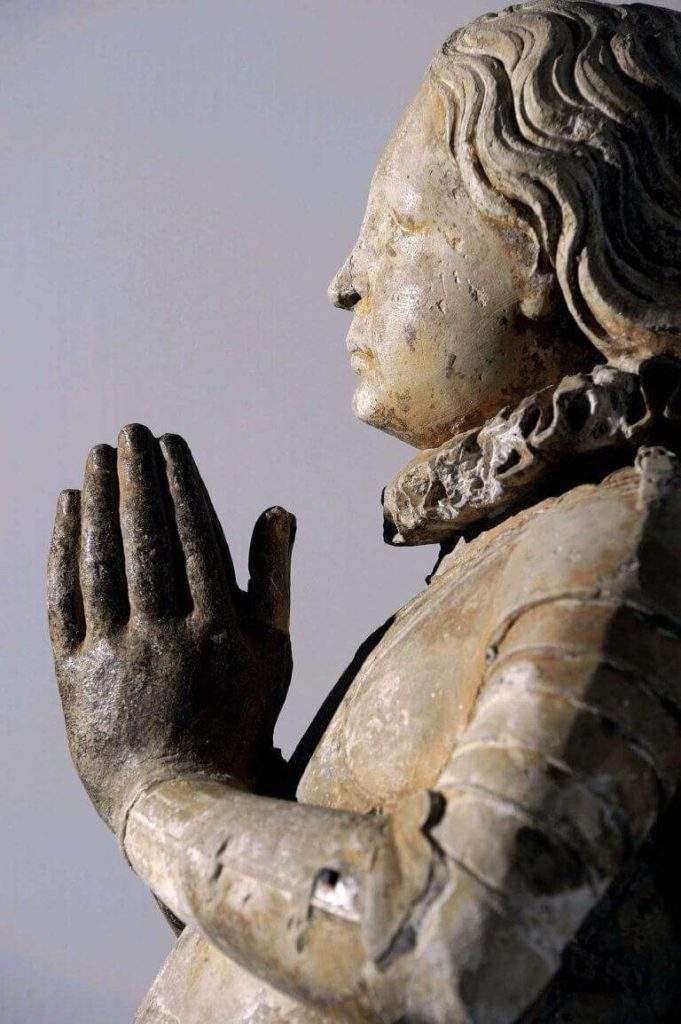
In his conclusions submitted to the DRAC in Orleans, Dr. Gorbenko writes: Information in our possession allows us to affirm that the Basilica of Notre-Dame de Cléry is a monument for France because it houses the graves and remains of at least four people who, during their lifetime, played a decisive role in the formation of the French state. In addition, we are currently studying the hypothesis that one of the skulls examined belongs to a world-renowned historical figure.
The Ukrainian scientist does not give his name.
Denise Reynaud, then deputy mayor of Cléry in charge of Cultural Affairs and Heritage, officially followed the work of Dr. Gorbenko who, on 16 October 2001, signed a secret agreement with the town hall on his future discoveries. She remembers: In 2001, I received Dr. Gorbenko and his associate Mr. Oleg Nesterenko who came for the facial reconstruction of Louis XI. They had all the necessary authorizations.
Mrs Reynaud will help the Ukrainian scientist as much as possible by purchasing photo films and the equipment necessary for his scientific mission. The work will be spread over several months in three periods. At the end of his last visit, on 12 January 2002, Dr Gorbenko invited us to his gîte in Cléry where he lived with his wife and children,” adds Mrs Reynaud. There were the mayor, Mr. Clément Oziel, the parish priest Robert Leroy, dean of the basilica, Jean-Marie Montigny, permanent deacon of the diocese of Orléans, Mrs. Martine Klein, Dr. Gorbenko’s landlady in the Paris region, and myself. He announced to us, very solemnly, over a glass of red wine and a few slices of sausage: ”I have found the skull of Joan of Arc and reconstructed her story”. He did not tell us how he had arrived at this discovery. We were surprised, a little shocked. We asked him to bring proof. Which he didn’t do. The parish priest was very surprised, the deacon even more so. But we didn’t say anything to anyone. The people of Cléry haven’t been told.
Deacon Jean-Marie Montigny confirms: Yes, he told us that he had found the skeleton of Joan of Arc, that made us laugh.
“The discovery of my life”
Martine Klein hosted Dr. Gorbenko throughout her stay in France. She followed his work and wrote his reports in French, both in the language of Goethe. One day, he returned from Cléry with Oleg Nestderenko, saying “I think I’ve made the discovery of my life,” she says. But he didn’t say any more than that. I didn’t ask any questions. A few months later, he revealed to me that he was a famous character. Then I would learn that it was Joan of Arc.
Martine Klein helped to classify the bones discovered by Dr. Gorbenko and to store them in small coffins for later burial. She is convinced that Sergei Gorbenko discovered the remains of Joan the Virgin because she knows him well, he is a very conscientious scientist who does not give information about his work lightly.
Sergueï Gorbenko had to return to his country in August 2002, his residence permit not having been renewed. According to Martine Klein it was very bitter that France did not recognize the significance of his work in the Basilica of Cléry.
He wrote his disappointment on January 8, 2003 in a letter to Mrs. Reynaud in approximate but very understandable French: I have serious proof that the skull of Joan of Arc belongs there. Of the hundred or so French cities would be happy to have a relic of only one finger. In your home, the skeleton of this one is complete.
Archaeological objects
A somewhat identical letter will be sent on 17 May 2005 to the Regional Cultural Affairs Directorate (DRAC) in Orléans. The scientist specifies that he has carried out an osteometric study of six skeletons and a craniometric study of twelve skulls in the Dunois chapel. I made the forensic study and the identification of these skeletons,” he wrote, adding that he had found remarkable archaeological objects, including two 15th century gold fibulae and a small dagger. All his bones were put in order by me and placed in boxes for later funerals. All this work was done in eight months.
Any proof ? Sergei Gorbenko doesn’t offer a shred of it. Not from the town hall of Cléry, not from the DRAC. He did discover the bones of Joan of Arc, and confirmed several times Oleg Nesterenko, the scientist’s former associate. But the evidence belongs to him, it is not for me to reveal it.
From Pulligny to Cléry?
Cléry and the Ministry of Culture have described these revelations as pure speculation since, it is said, the bones analyzed by Gorbenko have been moved so often that it is not certain that they belong to the Valois.
In any case, it is not forbidden to think that the remains of Jeanne des Armoises were transferred from Pulligny-sur-Madon to Cléry-Saint-André at the end of the 19th century. It is understandable that, in order to safeguard the legend of Joan of Arc, the Church erased all traces of Joan’s presence in the small Lorraine church. If this was the case, what was left of the bones of the Virgin could not be placed anywhere else but in the royal basilica of Cléry, where not only the King of France Louis XI, but above all Dunois, son of Louis of Orleans, rests for eternity. For Jeanne la Pucelle is Princess of Orleans. There would be nothing improbable that she would be buried here, among her own people.
Marcel GAY
What if Jeanne didn’t exist?
Let’s say the Virgin didn’t exist. If she hadn’t heard voices, if she hadn’t come to King Charles’ aid… what would have happened?
Simply the Treaty of Troyes, which has never been questioned, would have been enforced. In other words, the little French-English king, Henry VI, would have become king of England and king of France.
However, a good part of the English nobility was of French origin, starting with the king’s mother, Catherine of Valois.
At the English court, everyone spoke French – and even Occitan since Eleanor of Aquitaine, herself the granddaughter of a troubadour.
This explains why even today 63% of the English vocabulary is made up of words of French origin.
King Henri VI and his court had already settled in Paris, where the little monarch was crowned at Notre-Dame, although he could not be crowned in Rheims. In Paris where the climate is healthier than in London.
Moreover, the kingdom of France had about twenty million subjects, while the kingdom of England had only four! There is a good chance that the kingdom of France would have naturally absorbed the kingdom across the Channel. The English language would have disappeared. French would have become the universal language. The course of history would have been turned upside down.
Should we regret it?
M.G.

